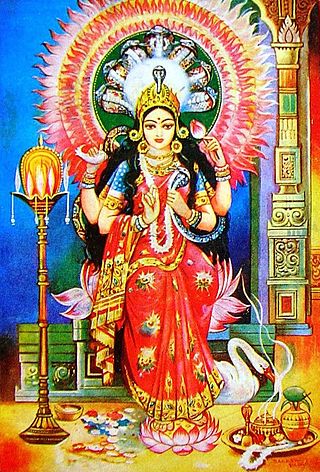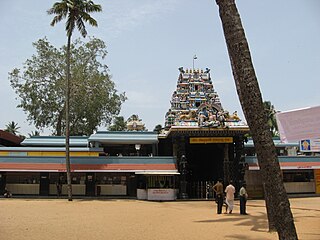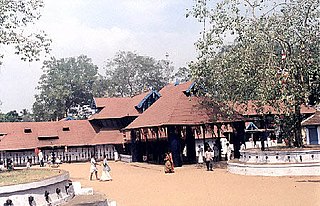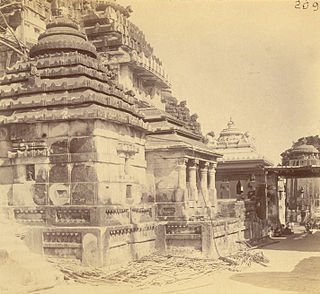
Lakshmi, also known as Shri, is one of the principal goddesses in Hinduism, revered as the goddess of wealth, fortune, prosperity, beauty, fertility, royal power and abundance. She along with Parvati and Sarasvati, forms the trinity called the Tridevi.

Vijayadashami, more commonly known as Dassahra in Hindi-Urdu, and also known as Dashāhra or Dashain in Maithili and Nepali, is a major Hindu festival celebrated every year at the end of Durga Puja and Navarahtri. It is observed on the tenth day of the month of Ashvin, the seventh in the Hindu lunisolar calendar. The festival typically falls in the Gregorian calendar months of September and October,more specifically between 27 September and 26 October.It is celebrated on the tenth day of the waxing moon(Shukla Paksha) of the Ashvayuja month

Sindoor or sindura is a traditional vermilion red or orange-red cosmetic powder from the Indian subcontinent, usually worn by married women along the part of their hairline. In some North Indian Hindu communities, the sindoor is a visual marker of marital status of a woman and ceasing to wear it usually implies widowhood.

Durga Puja, also known as Durgotsava or Shaaradotsava, is an annual festival originating in the Indian subcontinent which reveres and pays homage to the Hindu goddess Durga, and is also celebrated because of Durga's victory over Mahishasura. It is particularly celebrated in the Indian state of West Bengal,Odisha,Tripura, Bihar, Jharkhand, eastern Uttar Pradesh, Assam and by Hindus in Bangladesh. The festival is observed in the Indian calendar in the month of Ashvin, which corresponds to September–October in the Gregorian calendar. Durga Puja is a ten-day festival, of which the last five are of the most significance. The puja is performed in homes and public, the latter featuring a temporary stage and structural decorations. The festival is also marked by scripture recitations, performance arts, revelry, gift-giving, family visits, feasting, and public processions called a melā. Durga Puja is an important festival in the Shaktism tradition of Hinduism. Durga Puja in Kolkata has been inscribed on the intangible cultural heritage list of UNESCO in December 2021. In Cuttack(Odisha) Many Durga Idols are Crafted from Silver. 34 Puja mandaps are decorated with silver tableaus. In Odisha the pandals feature stunning decorations, showcasing traditional and contemporary themes that attract thousands of visitors. Durga Puja which is celebrated as Gosani Yatra in Puri. In this festival of Puri, several big clay idols of Mahisamardini Durga are worshipped every year in the month of Asvina (October).

Santoshi Mata or Santoshi Maa is a goddess, who is venerated as "the Mother of Happiness", the meaning of her name. Santoshi Mata is particularly worshipped by women of North India and Nepal. A vrata called the Santoshi Maa vrata is performed by women on 16 consecutive Fridays to win the goddess' favour.

Chiplun ( [t͡ʃipɭuːɳ]) is a city in Ratnagiri district in the state of Maharashtra, India. It is one of the financial and commercial hubs of Ratnagiri district, and the headquarters of Chiplun taluka. It is about 250 km south of Mumbai and 90 km North of Ratnagiri in the Konkan region of Maharashtra, on the Mumbai–Goa highway (NH-66). It has a long history and a strong cultural background. Recent decades have seen much industrial development in it and its and surrounding areas.

Saptashrungi or Saptashringi is a site of Hindu pilgrimage situated 60 kilometres (37 mi) from Nashik in Indian state of Maharashtra. According to Hindu traditions, the goddess Saptashrungi Nivasini dwells within the seven mountain peaks. It is located in Nanduri, Kalwan taluka, a small village near Nashik in India. The Marathas and some Hindu tribes have worshipped the goddess from a long time and some worship her as their kuldaivat. There are 510 steps to climb the gad. To go from below to the temple, the temple trust has also provided the facility of a furnacular trolley. Its work started in July 2018. There are a total of 6 coaches in this trolley, and 10 passengers can sit in one coach. This trolley takes 3 minutes to reach the temple. Passengers have to climb 20 to 25 stairs to go from the station above the trolley to the temple. This trolley carries about 5000 passengers every day. Devotees visit this place in large numbers every day. The temple is also known popularly as one of the "three and half Shakti Peethas" of Maharashtra. The temple is also one among the 51 Shakti Peethas located on the Indian subcontinent and is a location where one of Sati's limbs, her right arm is reported to have fallen. Its half shaktipeeth among three and half shaktipeeth of Maharashtra.

The Vishalakshi Temple, also known as Vishalakshi Gauri Mandir and Vishalakshi Amman Kovil. It is one of the famous Hindu temple at Varanasi. Dedicated to the goddess Vishalakshi. It was Built and Maintained by Nattukottai Nagarathar a mercantile community from Tamil Nadu
The Mariyamma Temple is situated in Boloor, India, dedicated to Goddess Mariyamma, situated approximately 5 km from Mangaladevi Temple in Mangalore city, Karnataka, India. It is believed that Mariyamma and Mangaladevi were sisters.

Manasa is a Hindu goddess of snakes. She is worshipped mainly in Bihar, Odisha, Bengal, Jharkhand, South Assam and other parts of northeastern India and in Uttarakhand, chiefly for the prevention and cure of snakebite, and also for fertility and prosperity. In Hinduism, Manasa is the sister of Shesha and Vasuki, king of Nāgas (serpents), and wife of sage Jaratkaru. She is the mother of the sage Astika. She is also known as Vishahari, Nityā (eternal) and Padmavati.

The Attukal Bhagavathy Temple is a Hindu shrine located at Attukal in Kerala, India. It is situated near the heart of the city, two kilometres away from the Padmanabhaswamy Temple, East Fort, in Thiruvananthapuram. The goddess of the temple is identified with Bhadrakali, mounted over a vetala. She is also identified with Kannagi, the heroine of Ilango Adigal's epic Cilappatikaram.

Sree Kurumba Bhagavati Temple is a Hindu temple at Kodungallur, Thrissur District, Kerala state, India. It is dedicated to the goddess Bhadrakali, a form of Mahakali or simply Durga or Aadi Parashakthi or Bhuvaneshwari worshipped and significantly revered in Kerala. The goddess is known also by the names "Sri Kurumba"". This temple is the head of 64 Bhadrakali temples in Kerala. This Mahakali temple is one of the oldest functioning temples in India. The goddess of the temple represents the goddess in her fierce ('ugra') form, facing North, featuring eight hands with various attributes. One is holding the head of the demon king Daruka, another a sickle-shaped sword, next an anklet, another a bell, among others.

Tulasi Vivaha, also called Tulasi Kalyanam, is a Hindu ritual, in which a symbolic ceremonial wedding takes place between a tulasi plant or holy basil and a shaligrama or an amla branch. Tulasi Vivaha signifies the end of the monsoon, and the beginning of the wedding season in Hinduism.

Mumba Devi Mandir is an temple in Mumbai, Maharashtra, India dedicated to the goddess Mumbā, the local incarnation of the Devi. Mumba Devi is the goddess of the city of Mumbai. The name Mumbai is derived from Mumba Devi. While Hindu sects devoted to the goddess Mumbadevi are attested to as far back as the 15th century, it is said that the temple was built in 1675 near the main landing site of the former Bori Bunder creek against the north wall of the English Fort Saint George by a Hindu woman also named Mumba. The creek and fort are now deteriorated to a point at which they are but derelict reminders of the city's past. The temple, on the other hand, is still active.
Panchkalshi is a Hindu community. They are one of the original native communities of Bombay (Mumbai) metropolitan area in the Konkan division of India. Since the 19th century the community has called itself Somvanshi Kshatriya Pathare (SKP).

The Vimala Temple or Bimala Temple is a Hindu temple dedicated to goddess Vimala or Bimala (ବିମଳା), located within the Jagannath Temple complex in Puri in the Indian state of Odisha. It is generally regarded as a Shakta pitha, among the holiest temples dedicated to the Hindu Goddess.

The MajorVellayani Devi Temple is a highly revered shrine in Kerala, India, dedicated to goddess Bhadrakali. The shrine is situated in Vellayani 1.5 km west of Vellayani junction, 12 km southeast of Thiruvananthapuram on the eastern bank of Vellayani Lake. The temple is under the management of Travancore Devaswom Board. The temple structure has a bronze roof with traditional art work and carries Dravidian architecture. The temple has eastern and northern towers called Gopurams with statues of different Gods sculptured in them. The Gopurams function as gateways through the walls that surround the temple complex.
Religion in Maharashtra is characterised by the diversity of religious beliefs and practices.

Sindur Khela, literally meaning 'vermillion game', is a Bengali Hindu tradition where women smear each other with sindur on Vijayadashami, the last day of the Durga Puja. On the day of the Vijayadashami after the conclusion of the ritual worship, married Bengali Hindu women apply sindur on the forehead and feet of the goddess and offer sweets to her. Then they put sindur on each other's faces and offer sweets to each other.

Balkumari Temple of Bhaktapur District is one of four Kumari temples in Kathmandu Valley. The temple was built in the 17th century. In 2015, the original idol of Digu Bhairav from the 17th century was stolen from the temple.



























